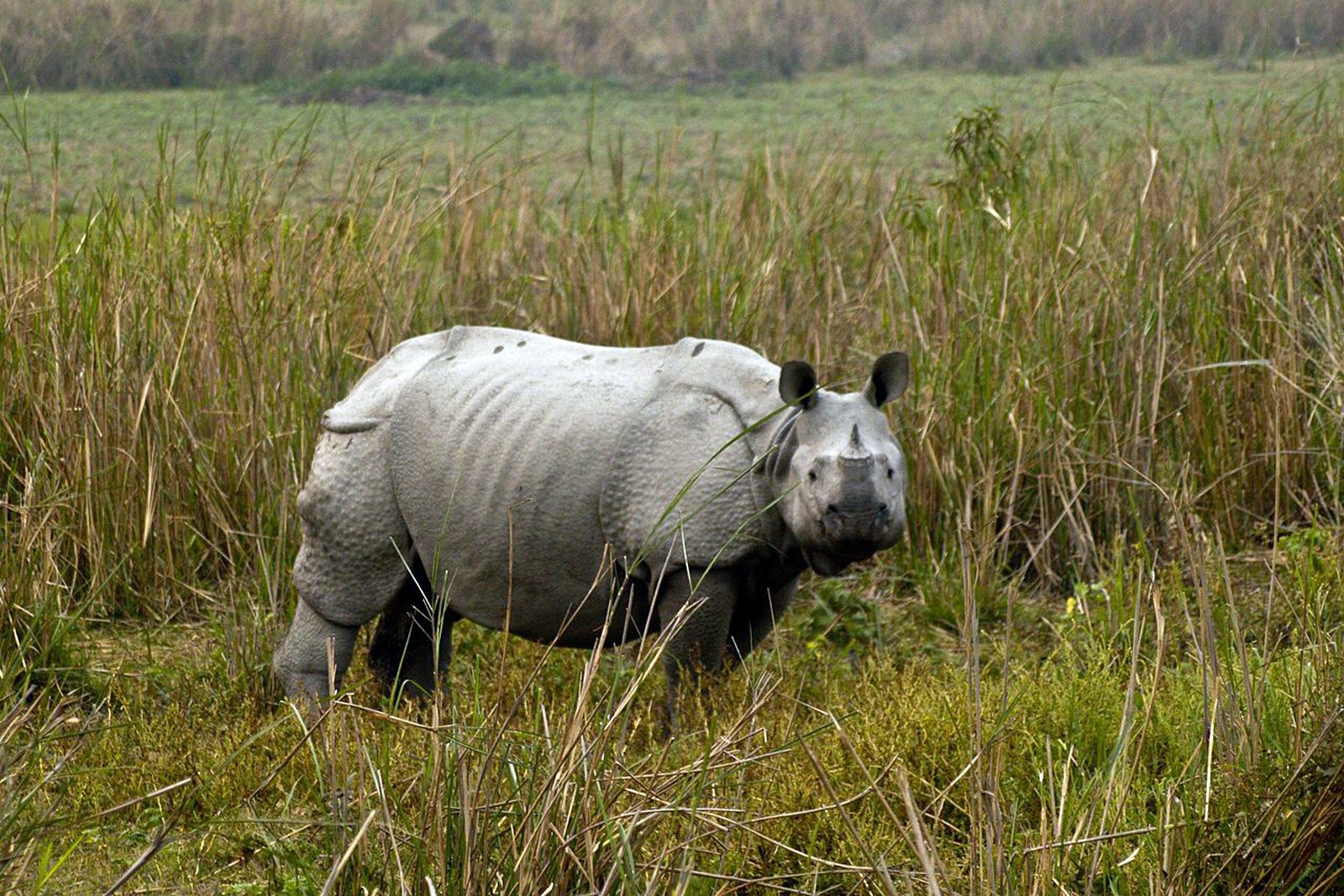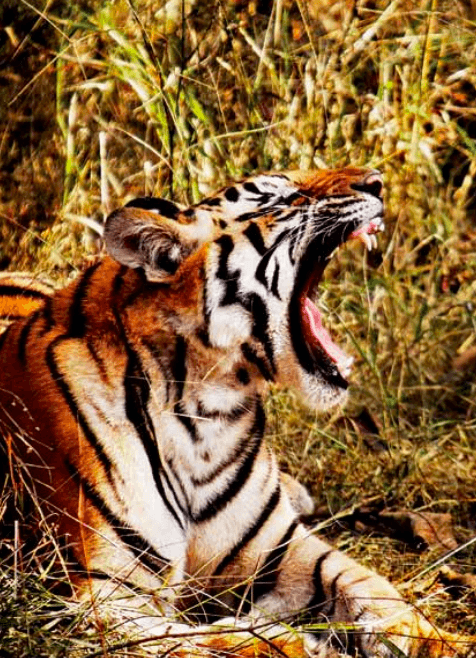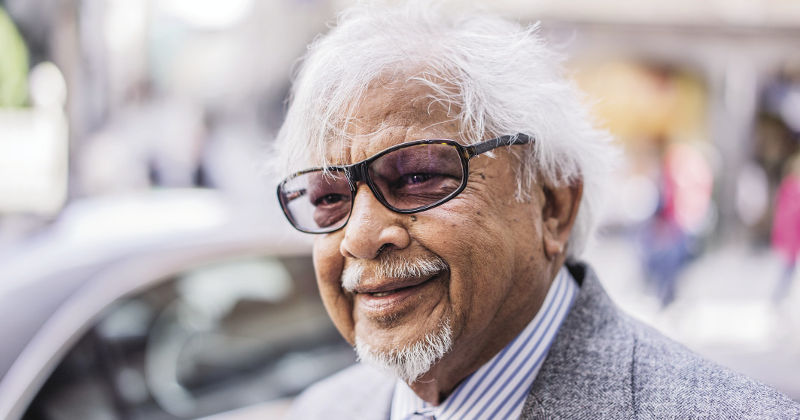Chitwan National Park
NEPAL CULTURAL & WILDLIFE TOURTravel to Nepal: Experience Culture and Wildlife of Nepal
7 Nights / 8 Days
This Wildlife Sanctuary is a preserved area in the Terai Lowlands of south-central Nepal, known for its biodiversity.
Its dense forests and grassy plains are home to rare mammals like one-horned rhinos and Bengal tigers. The park shelters numerous bird species, including the giant hornbill.
Dugout canoes traverse the northern Rapti River, home to crocodiles. Inside the park is Balmiki Ashram, a Hindu pilgrimage site.

Discover Unlimited Wildlife

Day 01: Arrival in Kathmandu.
Upon arrival at the airport, welcome by our representative & transfer to the Hotel followed by half day sightseeing tour of City.
Swoyambhunath
The four seeing eyes of Swoyambhunath Stupa watch over the valley from the top of 77-m high hillock on western side. This most glorious Stupa in the world is one of the holiest Buddhist sites in Nepal and its establishment is linked to the creation of Kathmandu valley out of a primordial lake. The surroundings of the Swoyambhunath are covered with small Chaityas & monasteries as well as some Hindu temples. The National Museum and the Museum of Natural History are situated at the foot of the hill.
Kathmandu Durbar Square:
This complex of palaces, courtyards and temples, built between 12th and 18th Centuries, used to be the seat of ancient Malla Kings of Kathmandu. It is the place where kings of Nepal are crowned and their coronations solemnized. An intriguing piece here is the 17th century stone inscription set into the wall of the palace with writings in 15 languages. Kumari Temple: Kumari temple is the residence of the Living Goddess. Kumari, known as Virgin Goddess has got some specialties, she must be chosen from a typical Newari cast with no body marks & injuries & will be replaced by another Kumari after puberty. Kasthamandap: Kasthamandap is believed to be constructed from the wood of a single tree in the sixteenth century situated near to the Kumari Temple. The name Kathmandu was named after this temple.
Day 02: Kathmandu
After breakfast, visit Pashupatinath Temple, Boudhnath Stupa and Patan City.
Nepal
Pashupatinath : Situated five kilometers east of Kathmandu on the bank of sacred Bagmati river, the stemple of lord Shiva Pashupatinath with two tiered golden roof and silver doors is famous for its super architecture. It is a centre of annual pilgrimage on the day of Maha Shivratri. Entrance to the temple precinct is permitted to the Hindus only however, visitors can clearly see the temple and activities performed in the temple premises from the eastern bank of the Bagmati river.
Boudhanath
Boudhanath is among the largest stupas in South Asia, and it has become the focal point of Tibetan Buddhism in Nepal. The white mound looms thirty-six meters overhead. The stupa is located on the ancient trade route to Tibet, and Tibetan merchants rested and offered prayers here for many centuries. When refugees entered Nepal from Tibet in the 1950s, many of them decided to live around Bouddhanath. They established many gompas, and the “Little Tibet” of Nepal was born. This “Little Tibet” is still the best place in the Valley to observe Tibetan lifestyle. Monks walk about in maroon robes. Tibetans walk with prayer wheels in their hands, and the rituals of prostration are presented to the Buddha as worshippers circumambulate the stupa on their hands and knees, bowing down to their lord.
Many people believe that Bouddhanath was constructed in the fifth century, but definite proof is lacking. The stupa is said to entomb the remains of a Kasyap sage who is venerable both to Buddhists and Hindus. One legend has it that a woman requested a Valley king for the donation of ground required to build a stupa. She said she needed land covered by one buffalo’s skin and her wish was granted by the King. She cut a buffalo skin into thin strips and circled off a fairly large clearing. The king had no choice but to give her the land.
The Bouddha area is a visual feast. Colorful thangkas, Tibetan jewellery, hand-woven carpets, masks, and khukuri knives are sold in the surrounding stalls. Smaller stupas are located at the base. Gompa monasteries, curio shops, and restaurants surround Bouddhanath. Conveniently situated restaurants with roof-top patios provide good food and excellent views of Bouddhanath.
Patan : Durbar Square, Situated I the heart of the city, constitutes the focus of visitors; attraction. The Square is full of ancient places, temples, and shrines, noted for their exquisite carvings. The Patan Durbar Square consists of three main chowks a Keshar Narayan Chowk. It was listed in the UNESCO World Heritage Monument List in 1979.
Patan Museum:- This museum inside the Durnbar Square specializes in bronze statues and religious objects. Krishna Mandir:- Built-in 1637 AD, the temple of Lord, Krishan holds a commanding position in the palace complex of Patan, Tibetan Refugee Camp: This camp was set up in 1960 under the initiative of the International Red Cross & the Swiss Development Corporation incorporation with HMG of Nepal. Its main objective is to help the Tibetan Refugees to do something nice & support themselves & some carpet industries & handicrafts have been operating.
Overnight at Hotel.
Day 03 Kathmandu/Chitwan Drive Kathmandu-Chitwan National Park. (180 km / 5 – 6 hrs.)
After breakfast, drive to Chitwan, about 5-hrs drive. Upon arrival at the Lodge welcome & briefing by the naturalist.. After Lunch, either canoe or elephant ride.
Day 04: Chitwan National Park:
A whole day full of jungle activities including Jungle walk, elephant ride, canoe ride, Elephant briefing OR Elephant bathing, Village visit OR Tharu Dance etc. Chitwan National Park is the most famous national park in Nepal. Which offers 450 species of birds including four species of deer, leopard, sloth bear, wild boar & much other wildlife. This park is well known for one horned Rhinoceros & it is a shelter for few Royal Bengal Tigers. Besides this, Chitwan also supports a great variety of flora & fauna. (Exact program in Chitwan can only be confirmed upon guest’s arrival at the resort as itinerary shall depend upon the occupancy in the resort and guest’s arrival/departure time)
Day 05: Chitwan / Pokhara: (175 km / 5 hrs.)
Early in the morning, after breakfast drive to Pokhara takes about 5-6 hours. Upon arrival at Pokhara transfer to the hotel and your rest of the day is free.
Day 06: Pokhara:
If Kathmandu is the cultural hub of Nepal, Pokhara is its center of adventure. An enchanting city nestled in a tranquil valley, it is the starting point for many of Nepal’s most popular trekking and rafting destinations. The atmosphere on the shore of Phewa Lake is one of excited vitality as hipster backpackers crowd the many bars and restaurants exchanging recommendations on guest houses and viewpoints, both by the lake and above the clouds.
Pokhara is a place of remarkable natural beauty. The serenity of Phewa Lake and the magnificence of the fishtailed summit of Machhapuchhre (6,977 m) rising behind it create an ambience of peace and magic. At an elevation lower than Kathmandu, it has a much more tropical feel to it, a fact well appreciated by the beautiful diversity of flowers which prosper in its environs. Indeed, the valley surrounding Pokhara is home to thick forests, gushing rivers, emerald lakes, and of course, the world famous views of the Himalaya.
The powerful rule of the old kings of Kathmandu, the Lichhavis and the Mallas, held sway over this valley for some time. As these dynasties fell prey to their own troubles, Pokhara Valley and the surrounding hills disintegrated into small kingdoms, frequently at war with each other. These were called the Chaubise Rajya or the Twenty-four Kingdoms. It was among these that Kulmandan Shah established his kingdom. His descendant Drabya Shah was the first to establish Gorkha, home of the legendary Gurkha warriors.
Pokhara is part of a once vibrant trade route extending between India and Tibet. To this day, mule trains can be seen camped on the outskirts of the town, bringing goods to trade from remote regions of the Himalaya. This is the land of the Magars and Gurungs, hardworking farmers and valorous warriors who have earned world-wide fame as Gurkha soldiers. The Thakalis, another important ethnic group here, are known for their entrepreneurship.
Afternoon half day sightseeing tour of Pokhara city.
Phewa Lake
Phewa Lake, the second largest lake in the Kingdom, is the center of all attraction in Pokhara. It is the largest and most enchanting of the three lakes that add to the resplendence of Pokhara. Here, one can sail or row a hired boat across to the water or visit the island temple in its middle. The eastern shore, popularly known as lakeside or Baidam, is the favorite home base for travellers and is where most of the hotels, restaurants and handicraft shops are located.
Seti Gandaki
Another of Pokhara’s natural wonders that unfailingly interests visitors is the Seti Gandaki river. Flowing right through the city, the boisterous river runs completely underground at places. Amazingly, at certain points the river appears hardly two meters wide. But its depth is quite beyond imagination over 20 meters! Mahendra Pul, a small bridge near the old Mission Hospital, provides a perfect view of the river’s dreadful rush and the deep gorge made by its powerful flow.
Barahi Temple
The Barahi temple is the most important monument in Pokhara. Built almost in the center of Phewa Lake, this two-storyed pagoda is dedicated to the boar manifestation of’ Ajima, the protesters deity representing- the female force Shakti. Devotees can be seen, especially on Saturdays, carrying male animals and fowl across the lake to be sacrificed to the deity.
Day 07 Pokhara/ Kathmandu(200 Kms/ 06 Hrs.)
After breakfast, drive to Kathmandu. Evening Free & Overnight Hotel.
Day 08 Kathmandu Departure
After breakfast morning free at leisure, in time transfer to Tribhuvan Intl. Apt to connect departure flight.
Testimonials from Happy Returning Customers of Travel Passion Inc.

"Made me a Passionate Traveler"
TRAVEL PASSION INC. has made me a passionate traveler. I disliked traveling because is disliked chaos and cancellations but when I got introduced to Travel Passion Inc., a unique and personalized travel agency, they changed my perceptions of traveling. Now I hand over all the organizing details to them and they have never failed me. I am not talking simply of one or two travel plans. They have been my agents for close to ten years and they have handled my groups of up to 34 people and I have never had an excuse to be unhappy or to complain. It is a travel agency with passionate zeal and, though small, they give you the service that leaves you with a smile.
Love Appa
Dr. Arun Gandhi - Grandson of Mahatma Gandhi “Father of Nation”
Video Testimonials from the travellers.
We were a group with many special requests about our itinerary, side trips, interests. Travel Passion and its guides were so wonderful about listening, understanding and giving us our wonderful experience in and with India…with appreciation and love
Susan and I have enjoyed three trips arranged through Travel Passion Inc.
Each one was a bit different. One was the Tour with the E. Stanley Jones Foundation and that trip visited the Ashram founded by Dr. Jones as well as the traditional sites in Northern India.
Our second trip was with the Gandhi Tour, but Susan wanted to do some extra travel, so you arranged for us to visit the South of India before joining the tour.
Finally, you arranged for a special tour for Susan to view some of the textiles in Northern India.
All of these tours involved full accommodations, expert guides, and all necessary transportation from the time we landed to the time we departed.
Outstanding, high-quality customer-oriented service that attended to our every need and wish. Truly a once in a lifetime adventure.
Thank you.
Bascom "Dit" Talley
Washington DC, USA
Frequently Asked Questions
Q. Traveling to Incredible INDIA and THE SUB-CONTINENT
A. India is a place where destination knowledge and on-ground connectivity is important. With our help, traveling to Incredible India and the Subcontinent is an enjoyable and hassle-free experience.
Travel Passion India (Inc.) provides expert advice, tailor-made itineraries and on-the-ground support with knowledgeable guides, comfortable transportations, and best-in-class hotels.
We take care of the granular details so you can enjoy the grandeur of this incredible, timeless, culturally diverse region.
Q. How to Book my tour?
A. To start off, booking your tour to Incredible India - Look out for Get a Free Quote form which is almost on every page on our website.
Or you can click on the Top Navigation link on the Right corner of the page - Contact for India Tours. (Do leave your phone numbers - as a secondary option - so we can reach out with text messages.)
Or you may consider dropping us an email at mail[at]travelpassioninc{dot}com - (do add us in your contact list - as sometimes email lands up in SPAM box.)
Or you can call us at +91-9811-212-458
Or drop us a message on social media - like Facebook, Twitter or Linkedin.
Q. Does Travel Passion India provides Travel Insurance?
A. No. We Don't. We highly recommend that all travelers purchase adequate trip cancellation, health and baggage insurance prior to travel. It is imperative to carry insurance coverage details with you during the tour.
Q. What are the Health Checks need to make before travelling to India?
We strongly recommend our travellers to carry mosquito repellent lotions / cream during holiday tour.
There are no compulsory vaccinations for traveling to India, although it is strongly recommended that you protect yourself during traveling against the following:
- Tetanus,
- Typhoid,
- Hepatitis A,
- Cholera
- Malaria.
We advise you to consult your doctor allowing at least 4 weeks before the date of travel for all medical advice.
Some areas including Bhutan and Nepal may be at high altitudes. So, people with respiratory ailments need to check with their doctor.
An inoculation against Yellow fever is required if you have visited any infected areas within 5 days prior to your arrival in India.
Q. How to Apply for eVisa for India?
E-TOURIST VISA (eTV)
e-Tourist Visa (eTV) is allowed for multiple visits in a calendar year and can be applied for 120 days prior to departure.
e-Tourist Visa (eTV) once issued it is valid for multiple entry, for 365 days from the date of issue and is non-extendable and non-convertible.
Continuous stay during each visit should not exceed 180 days
To apply for eTV please log on here.
https://indianvisaonline.gov.in/evisa/tvoa.html
Q. What's the Weather in India like?
India is a vast country with diverse seasonal and geographical variations in climate.
Generally, the best time to visit India for your holidays is during the months of October to April.
The Monsoon season starts in mid-May till August - you may like to know about off-season deals. Wildlife sanctuaries & National Parks of India are closed during the Monsoon period.
The summer season is from May to July, in North India. Whereas in July the lower plains of South India start to have some monsoon showers.
